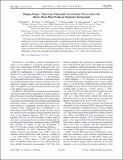| dc.contributor.author | Regimbau, T. | |
| dc.contributor.author | Christensen, N. | |
| dc.contributor.author | Sathyaprakash, B. | |
| dc.contributor.author | Evans, Matthew J | |
| dc.contributor.author | Katsavounidis, Erotokritos | |
| dc.contributor.author | Vitale, Salvatore | |
| dc.date.accessioned | 2017-05-11T19:11:07Z | |
| dc.date.available | 2017-05-11T19:11:07Z | |
| dc.date.issued | 2017-04 | |
| dc.identifier.issn | 0031-9007 | |
| dc.identifier.issn | 1079-7114 | |
| dc.identifier.uri | http://hdl.handle.net/1721.1/108853 | |
| dc.description.abstract | The merger rate of black hole binaries inferred from the detections in the first Advanced LIGO science run implies that a stochastic background produced by a cosmological population of mergers will likely mask the primordial gravitational wave background. Here we demonstrate that the next generation of ground-based detectors, such as the Einstein Telescope and Cosmic Explorer, will be able to observe binary black hole mergers throughout the Universe with sufficient efficiency that the confusion background can potentially be subtracted to observe the primordial background at the level of Ω[subscript GW] ≃10[superscript -13] after 5 years of observation. | en_US |
| dc.description.sponsorship | National Science Foundation (U.S.) | en_US |
| dc.description.sponsorship | Laser Interferometer Gravitational Wave Observatory | en_US |
| dc.publisher | American Physical Society | en_US |
| dc.relation.isversionof | http://dx.doi.org/10.1103/PhysRevLett.118.151105 | en_US |
| dc.rights | Article is made available in accordance with the publisher's policy and may be subject to US copyright law. Please refer to the publisher's site for terms of use. | en_US |
| dc.source | American Physical Society | en_US |
| dc.title | Digging Deeper: Observing Primordial Gravitational Waves below the Binary-Black-Hole-Produced Stochastic Background | en_US |
| dc.type | Article | en_US |
| dc.identifier.citation | Regimbau, T. et al. “Digging Deeper: Observing Primordial Gravitational Waves below the Binary-Black-Hole-Produced Stochastic Background.” Physical Review Letters 118.15 (2017): n. pag. © 2017 American Physical Society | en_US |
| dc.contributor.department | Massachusetts Institute of Technology. Department of Physics | en_US |
| dc.contributor.department | MIT Kavli Institute for Astrophysics and Space Research | en_US |
| dc.contributor.department | LIGO (Observatory : Massachusetts Institute of Technology) | en_US |
| dc.contributor.mitauthor | Evans, Matthew J | |
| dc.contributor.mitauthor | Katsavounidis, Erotokritos | |
| dc.contributor.mitauthor | Vitale, Salvatore | |
| dc.relation.journal | Physical Review Letters | en_US |
| dc.eprint.version | Final published version | en_US |
| dc.type.uri | http://purl.org/eprint/type/JournalArticle | en_US |
| eprint.status | http://purl.org/eprint/status/PeerReviewed | en_US |
| dc.date.updated | 2017-04-14T22:00:06Z | |
| dc.language.rfc3066 | en | |
| dc.rights.holder | American Physical Society | |
| dspace.orderedauthors | Regimbau, T.; Evans, M.; Christensen, N.; Katsavounidis, E.; Sathyaprakash, B.; Vitale, S. | en_US |
| dspace.embargo.terms | N | en_US |
| dc.identifier.orcid | https://orcid.org/0000-0001-8459-4499 | |
| dc.identifier.orcid | https://orcid.org/0000-0001-6550-3045 | |
| dc.identifier.orcid | https://orcid.org/0000-0003-2700-0767 | |
| mit.license | PUBLISHER_POLICY | en_US |
| mit.metadata.status | Complete | |
